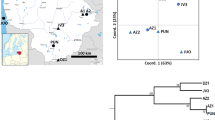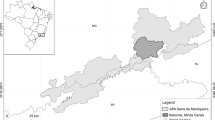Abstract
Advanced-generation domestication programs for forest-tree species has raised some concerns about the maintenance of genetic diversity in forest-tree breeding programs. Genetic diversity in natural stands was compared with two genetic conservation options for a third-generation elite Pinus taeda breeding population. The breeding population was subdivided either on the basis of geographic origin and selection goals (multiple-population or MPBS option) or stratified according to genetic value (hierarchical or HOPE option). Most allelic diversity in the natural stands of loblolly pine is present in the domesticated breeding populations. This was true at the aggregate level for both multiple-population (MPBS) and the hierarchical (HOPE) populations. Individual subpopulations within each option had less genetic diversity but it did not decline as generations of improvement increased. Genetic differentiation within the subdivided breeding populations ranged from 1 to 5%, genetic variability is within each subpopulation rather than among subpopulations for both MPBS (>95%) and the HOPE approaches (>98%). Nei's Gst estimates for amongpopulation differentiation were biased upwards relative to estimates of θ from Weir and Cockerham (1984).
Similar content being viewed by others
References
Bachmann K (1994) Molecular markers in plant ecology. New Phytol 126:403–418
Barnes RD (1984) A multiple population breeding strategy for Zimbabwe. In: Barnes RD, Gibson GL (eds) Proceedings IUFRO provenance and genetic improvement strategies in tropical forest trees. Commonwealth Forestry Institute, Oxford UK
Bramel-Cox PJ, Cox TS (1988) Use of wild germplasm in sorghum improvement. 43rd Annual Corn and Sorghum Conference 43: 13–26
Brown AHD (1989) Core collections: a practical approach to genetic resources management. Genome 31:818–824
Burdon RD, Namkoong G (1983) Short note: multiple populations and sublines. Silvae Genet 32:221–222
Cockerham CC, Weir BS (1993) Estimation of gene flow from Fstatistics. Evolution 47:855–863
Cotterill PP (1984) A plan for breeding radiata pine. Silvae Genet 33: 84–90
Crow JF, Kimura M (1970) An introduction to population genetics theory. Harper and Row, New York
Eriksson G, Namkoong G, Roberds JH (1994) Dynamic gene conservation for uncertain futures. For Ecol Management 62: 15–37
Groover AT, Devey M, Fiddler T, Lee J, Megraw R, Mitchell-Olds T, Sherman B, Vujcic S, Williams CG, Neale DB (1994) Identification of quantitative trait loci influencing wood specific gravity in an outbred pedigree of loblolly pine. Genetics 138(4): 1293–1300
Hamrick JL, Godt MJW, Sherman-Broyles SL (1992) Factors affecting levels of genetic diversity in woody plant species. New Forests 6:95–124
Kannenberg LW (1984) Utilization of genetic diversity in crop breeding. In: Yeatman CW, Kafton D, Wilkes G (eds) Plant genetic resources: a conservation imperative, AAAS Selected Symposium 87th edn. Westview Press, Boulder, Colorado
Kidd G (1993) Analyzing the U.S. corn-genetics business. Biotechnology 11(9): 980
Lewis PO, Whitkus R (1989) GENESTAT for microcomputers. Am Soc Plant Taxon Newslett 2:15–16
Lindgren D, Gregorius H (1976) Inbreeding and coancestry. In: Proceedings, IUFRO Joint Meeting on Advanced Generation Breeding, Bordeaux France, pp 49–72
Lowe WJ, van Buijtenen JP (1986) The development of a sublining system in an operational tree improvement program. In: Proceedings IUFRO Conference on Breeding theory, Progeny testing and Seed Orchards, Williamsburg, Virginia, pp 98–106
Mahalovich MF (1989) Modelling positive assortative mating and elite populations in recurrent selection programs for general combining ability. PhD dissertation, NC State University, Raleigh, North Carolina
McKeand SE, Bridgwater FE (1992) Third-generation breeding strategy for the North Carolina State University-Industry cooperative tree improvement program. In: Proceedings, IUFRO Conference on Breeding Tropical Trees, pp 234–240
McKeand SE, Li B, Hatcher A, Weir RJ (1988) Stability parameter estimates for sstem volume for loblolly pine families growing in regions in southeastern U.S. For Sci 38(1): 10–17
Mitton JB, Linhart YB, Sturgeon KB, Hamrick JL (1979) Allozyme polymorphism detected in mature needle tissue of ponderosa pine. JHered 70:86–89
Moran GF, Bell JC, Eldridge KG (1988) The genetic structure and genetic conservation of the five natural populations of Pinus radiata. Can J For Res 18:506–514
Namkoong G (1984) A control concept of gene conservation. Silvae Genet 33:160–163
Nei M (1972) Genetic distance between populations. Am Nat 106: 282–292
Nei M (1973) Analysis of gene diversity in subdivided populations. Proc Natl Acad Sci USA 70:3321–3323
Nei M (1977) F-statistics and analysis of gene diversity in subdivided populations. Ann Hum Genet 41:225–233
Nei M (1986) Definition and estimation of fixation indices. Evolution 40:643–645
Nei M, Chesser RK (1983) Estimation of fixation indices and gene diversities. Ann Hum Genet 47:253–259
Nei M, Roychoudhury AK (1974) Sampling variances of heterozygosity and genetic distance. Genetics 76:379–390
Nei M, Maruyama T, Chakraborty R (1975) The bottleneck effect and genetic variability in populations. Evolution 29:1–10
Soltis DE, Haufler CH, Darrow DC, Gastony GC (1983) Starchgel electrophoresis of ferns: a compilation of grinding buffers, gel and electrode buffers and staining schedules. Am Fern Jour 73:9–27
Weir BS (1990) Genetic data analyses. Sinauer, Sunderland, Massachusetts
Weir BS, Cockerham CC (1984) Estimating F-statistics for the analysis of population structure. Evolution 38:1358–1370
Williams CG, Lambeth CC (1993) Experimental elite population using Pinus taeda L. In: Proceedings, IUFRO Conference on Breeding Tropical Trees, Cali Colombia, pp 223–233
Williams CG, Neale DB (1992) Conifer wood quality and markerassisted selection: a case study. Can J For Res 22:1009–1017
Workman PL, Niswander JD (1970) Population studies on southwestern Indian tribes. II. Local genetic differentiation in the Papago. Am J Hum Genet 22:24–49
Wright S (1931) Evolution in Mendelian populations. Genetics 16: 97–159
Wright S (1943) Isolation by distance. Genetics 28:114–138
Wright S (1965) The interpretation of population structure by F-statistics with special regard to systems of mating. Evolution 19:355–420
Wright S (1977) Evolution and the genetics of populations, vol 3. Experimental results and evolutionary deductions. University of Chicago Press, Chicago
Author information
Authors and Affiliations
Additional information
Communicated by P. M. A. Tigerstedt
Rights and permissions
About this article
Cite this article
Williams, C.G., Hamrick, J.L. & Lewis, P.O. Multiple-population versus hierarchical conifer breeding programs: a comparison of genetic diversity levels. Theoret. Appl. Genetics 90, 584–594 (1995). https://doi.org/10.1007/BF00222007
Received:
Accepted:
Issue Date:
DOI: https://doi.org/10.1007/BF00222007




